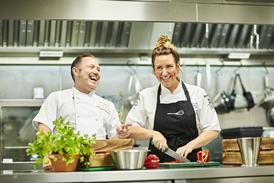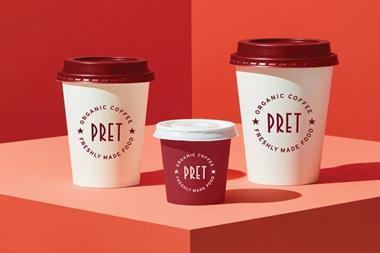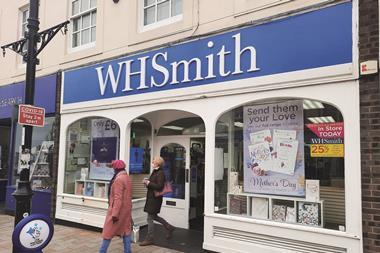When the going gets tough in retail, it may be tempting for suppliers to diversify into foodservice. But there’s more to it than bigger packs. Linda Pettit reports
Supplying UK retail business is one of the toughest markets to crack - it’s competitive, demanding, price-led and volatile. So what about branching into foodservice?
It’s an attractive proposition with out-of-home sales worth 34p in every food pound spent, a figure that is predicted to grow to 50p in the next decade. Sales through catering are worth £25bn through some 262,000 outlets, according to the latest figures from British Hospitality Association.
Foodservice could represent a valuable new revenue stream for suppliers and could even be used to launch brands, but it’s not an easy option.
Most of its existing suppliers stress the complexity of the supplier/customer relationship and the fact that you not only have to know the market and decide who you’re targeting, but also ensure your product meets the needs of those operators, the customers they serve and the wholesalers who’ll distribute it.
Critically, you have to understand the consumer in an out-of home environment.
Encouraging Scottish food manufacturers to target foodservice clients is a particular focus for Scottish Enterprise, which held a foodservice conference last year.
Its regular ‘dining clubs’, where suppliers send their products to a restaurant to be cooked by the chef, have proved so successful they have now been rolled out across Scotland.
In this initiative, a selection of suppliers have the opportunity to showcase products and the evenings have proved a useful networking tool for at least one company, which has now picked up a local hotel contract from a local hotel.
A recent study by Scottish Enterprise showed 82% of suppliers listed foodservice as a key business opportunity, with 52% reporting growth of over 20% from foodservice in the past year.
“It’s another opportunity. A lot of people are considering it and it’s something we’re trying to encourage,” says a spokeswoman. But she warns you can’t just roll out a retail product to foodservice. “Caterers like to think they’re different in what they want.”
This is echoed by Mackie’s foodservice manager Raymond Pirie. The well-established Scots ice cream manufacturer moved into foodservice three years ago and six months later appointed Pirie to develop the business. “Caterers hate a retail pack made bigger - that’s not what it’s about,” he says. “We are developing new products for them, it’s about establishing a partnership.
Pirie warns that distribution in particular can be a trickier proposition than in retail. “Whether you establish links with the customer or the wholesaler depends on who you are targeting,” he says. “There’s a lot of negotiating to be done involving the distributors and their contacts.”
Foodservice operators in general don’t run their own supply chain either, so not only do you have to build a relationship with your ultimate customer, you have to have a good relationship with the distributor or wholesaler too.
Jon Walsh, marketing director of Nestlé Foodservice, adds that distribution tends to take longer. “Launching a new product in retail and you get 90% distribution in three months. In catering it can take a year.”
No companies in foodservice have more than a 5% market share by value and over 90% of foodservice businesses have an annual turnover of less than £250,000.
The large hotel and restaurant chains like Whitbread, Pizza Express and The Restaurant Group (formerly Garfunkels), as well as the big contract caterers like Compass and Sodhexo tend to buy, or negotiate, direct.
So it’s important to decide who you’re aiming at - contract caterers, fine dining restaurants, the branded chains or the wholesale sector. Wholesalers represent the largest distribution route into foodservice, with national companies such as 3663, Brakes and Booker, who all supply some of the national chains as well as smaller companies, down to smaller, more specialist or regional wholesalers.
It’s worth remembering success in retail is no guarantee in foodservice, however big your brand. Having worked for Whitbread for many years, Mark Allibone now commercial director of The Sauce Company, knows foodservice well. The Sauce Company supplies both retail and catering, with 68% of its soups and sauces business in foodservice and 32% in retail.
“You have to take a longer term view with foodservice,” he says. “You have to adopt a bread today, jam tomorrow approach.” Neither, he says, can you cherrypick big lines to supply, as a customer in foodservice might just want 12 cases of a product. “You have to have a partnership and it might be low volume to begin with. But it’s a refreshing, open partnership and one in which customers are very honest about where they are going and what they want to achieve.”
And it’s certainly not a question of simply providing larger pack sizes. Allibone points out that foodservice operators have very different needs in terms of compliances, packaging and storage of the product. Some can handle chilled, some can’t, some have the skill to add value to the product, others want a more finished product.
“You have to be very adaptable. Foodservice wants brand differentiation, too. One pub company will want something very different to another. Often divisions within one company want differentiation. You have to be willing to do that.”
Global giant Procter & Gamble is best
known for its retail brands, ranging from Pringles to Ariel, but the company has supplied foodservice with snacks and beverages and laundry and cleaning systems for 20 years. Mat Baker, sales director of P&G Professional, says the market represents an important opportunity for P&G to bring its consumer expertise into out-of-home. Ariel, Flash and Fairy are supplied into contract catering, hotels and although the products share brand names, the professional formulations are different.
P&G also runs its Professional business alongside its retail one, rather than separating them out.
“We talk about being brilliantly focused and brilliantly attached,” says Baker. “You have to be focused to be successful - a lot of companies fail who try to sell retail brands into foodservice.
“You have to be serious about the market. It’s about commitment.”
Baker agrees that big brand names don’t necessarily succeed in foodservice and with its limited distribution network it can be difficult to gain a foothold.
But for Baker, the foodservice market is one that’s worth investing in. “You develop long-term partners with customers that would be the envy of my retail colleagues,” he says, adding that some contracts can be for as long as five years - “it becomes highly collaborative and an interesting place to be. It’s not just a transactional relationship.”
The biggest foodservice supplier in the market is 3663, which has an annual turnover of £1bn, around 9,500 product lines and around 30,000 customers.
Des Bell, director of marketing, says that making a successful switch from retail to foodservice is a combination of the product, the company and the brand, but again emphasises the need to understand the customer. “Companies that have products that are targeted at retail must understand what drives the needs of consumers in foodservice, whether it be in prisons, hospitals or restaurants, but also what drives operators’ needs as well as those of suppliers such as ourselves.
“If a product is appropriately positioned it can lead to a successful foodservice business, but foodservice is an amalgam of markets - it’s very different selling into hospitals, schools and pubs, there are different consumer expectations, different customer needs and constraints.”
In a pub, for instance, a consumer will want to eat sitting down, while in a sport centre they will probably be after something to go, he says, adding: “I think in harder times in retail, suppliers do look for other opportunities. In foodservice you can build brands at a fraction of the price you can in retail, which is dependent on promotions, but you need to be clear about what you want foodservice to do for your business.”
Walsh is less reticent. His advice to potential foodservice suppliers is “just go for it”. Nestlé has long been a successful player in the foodservice sector with its Nescafé brand, the culinary brand Maggi, aimed at chefs and its multi-snack vending products.
Walsh says the company’s policy of extending brands into foodservice has been very successful, particularly for Nescafé and Kit Kat. But not every brand will make the transfer: “Our thinking has changed on this. Now where it makes sense to pull through brands into foodservice, we will. We’ve learnt the places where it makes sense.”
In the final assessment, Walsh believes that the similarities with retail are greater than the differences.
“The same fundamentals apply, although you have one extra element - the end user, so there are four stages than three.”
Anyone eyeing the market, just needs to do their homework, he advises.
“You have to be much more precise and have more finesse as it’s not just about getting the four or five big customers. You have to judge the pace right.”
Top tips
From retail to catering...
>>How to be successful in foodservice
1 Ensure you have the capacity to supply the foodservice market - dealing with large contract caterers or branded restaurant groups could take up significant production capacity so decide what level you want to operate at.
Consider efficiencies of capacity - short runs as well as the particular packaging requirements of the foodservice sector.
The Sauce Company’s Mark Allibone warns that taking on more business could mean you take your eye off the ball when it comes to your retail clients.
2 Develop a well-targeted plan for your foodservice ambitions, which includes the product, price, service, financials and marketing. Do not assume that success in retail means you will be successful in foodservice.
3 Never give up, says Mackie’s Raymond Pirie. Getting listings with the foodservice sector won’t happen overnight, it takes patience, hard work and time, “but a movement into foodservice is deemed to be a profitable opportunity” he says.
4 Be focused, try to understand the caterer as their needs are completely different to those of the retail sector - their customer is different, as is the supply chain, the relevance of brands, and the margins they expect to work on, says Procter & Gamble’s Professional’s Mat Baker.
“It’s not just about the size of your company, it’s about your attitude, and it’s not just about selling products.”
5 “Understand the market,” says 3663’s Des Bell. “Foodservice is a number of different markets and you need to understand what you have to offer and what role foodservice is to play in your business.
“More enlightened companies will trial a product within the foodservice sector before launching it in retail, although this is more common outside the UK.”
>>HIGHLAND SPRING, SACLA’ AND ARLA EXPLAIN HOW FOODSERVICE HAS WORKED FOR THEM
Highland Spring views foodservice as an important sector of its business. The company created a foodservice team five years ago and sales are growing at 25% per year. It supplies many major foodservice wholesalers such as DBC, 3663, Brakes and Peter’s Foodservice. It also operates in the foodservice sector of both Dairy Crest and Express Dairies and the travel market - British Airways is an established channel.
“The line between on-trade wholesale and foodservice is eroding,” says marketing director Sally Stanley. “We are combining our on-trade and foodservice teams into one dedicated, specialist team with responsibility for foodservice wholesale, on-trade and travel. This will allow us to provide these sectors with a focused resource and to maximise the brand’s potential.
“A key component of future strategy for the foodservice sector will focus on category management - as important to foodservice as it is to grocery. Catering wholesalers can benefit from efficiencies produced by reducing the number of lines stocked and rationalising ranges.”
Sacla’, the well-established Italian sauce brand, launched a foodservice range just 15 months ago, having researched the market.
“We have been enormously encouraged by the early acceptance of the product type and the Sacla’ brand name,” says a spokesman.
“Understanding the foodservice market is very different to that of a retail brand. A principal focus for the two products in the Sacla’ range has been education in usage. We’ve demonstrated the range’s versatility which, combined with a great flavour, has led to a wide menu appearance for the pesto range.With such affirmative feedback and increasing take up of the brand we are considering a review and extension of the range.”
Since Arla trumpeted its plans the year before last to double its foodservice business to £100m by 2007 and achieve sector domination, the dairy giant has been busily working behind the scenes to pull off its ambitious targets.
But the foodservice division found itself with more on its plate in October last year following Arla’s merger with Express Dairies.
The merger brought a wide range of products to the foodservice portfolio, including morning goods, beverages, soups, yogurts as well as more butters, spreads and an organic collection. Arla has absorbed Express Foodservice’s dedicated telesales teams and gained a stronger penetration in the south.
According to channel marketing manager Emma Williams, activity has been particularly strong across its milk business. Flavoured milk drink brand Café Met has gained listings in 3663, Compass, DBC and Peter’s as well as Booker and Makro while a Cravendale PurFiltre milk pergal dispensing unit has been tested in hotels, leisure, quick service restaurants and in the education sector.
“The pergal delivers increased brand awareness and encourages product trial while offering all the other benefits, such as longevity and less wastage. It is a quality milk offering for front of house and therefore an incremental sales opportunity,” she says.
Key to Arla’s strategy is industry research and the company has become a patron supplier of the Restaurant Association. “Hands-on industry research is now at the core of our development activity,” says Williams. “The results will help steer our products and marketing.”
Supplying UK retail business is one of the toughest markets to crack - it’s competitive, demanding, price-led and volatile. So what about branching into foodservice?
It’s an attractive proposition with out-of-home sales worth 34p in every food pound spent, a figure that is predicted to grow to 50p in the next decade. Sales through catering are worth £25bn through some 262,000 outlets, according to the latest figures from British Hospitality Association.
Foodservice could represent a valuable new revenue stream for suppliers and could even be used to launch brands, but it’s not an easy option.
Most of its existing suppliers stress the complexity of the supplier/customer relationship and the fact that you not only have to know the market and decide who you’re targeting, but also ensure your product meets the needs of those operators, the customers they serve and the wholesalers who’ll distribute it.
Critically, you have to understand the consumer in an out-of home environment.
Encouraging Scottish food manufacturers to target foodservice clients is a particular focus for Scottish Enterprise, which held a foodservice conference last year.
Its regular ‘dining clubs’, where suppliers send their products to a restaurant to be cooked by the chef, have proved so successful they have now been rolled out across Scotland.
In this initiative, a selection of suppliers have the opportunity to showcase products and the evenings have proved a useful networking tool for at least one company, which has now picked up a local hotel contract from a local hotel.
A recent study by Scottish Enterprise showed 82% of suppliers listed foodservice as a key business opportunity, with 52% reporting growth of over 20% from foodservice in the past year.
“It’s another opportunity. A lot of people are considering it and it’s something we’re trying to encourage,” says a spokeswoman. But she warns you can’t just roll out a retail product to foodservice. “Caterers like to think they’re different in what they want.”
This is echoed by Mackie’s foodservice manager Raymond Pirie. The well-established Scots ice cream manufacturer moved into foodservice three years ago and six months later appointed Pirie to develop the business. “Caterers hate a retail pack made bigger - that’s not what it’s about,” he says. “We are developing new products for them, it’s about establishing a partnership.
Pirie warns that distribution in particular can be a trickier proposition than in retail. “Whether you establish links with the customer or the wholesaler depends on who you are targeting,” he says. “There’s a lot of negotiating to be done involving the distributors and their contacts.”
Foodservice operators in general don’t run their own supply chain either, so not only do you have to build a relationship with your ultimate customer, you have to have a good relationship with the distributor or wholesaler too.
Jon Walsh, marketing director of Nestlé Foodservice, adds that distribution tends to take longer. “Launching a new product in retail and you get 90% distribution in three months. In catering it can take a year.”
No companies in foodservice have more than a 5% market share by value and over 90% of foodservice businesses have an annual turnover of less than £250,000.
The large hotel and restaurant chains like Whitbread, Pizza Express and The Restaurant Group (formerly Garfunkels), as well as the big contract caterers like Compass and Sodhexo tend to buy, or negotiate, direct.
So it’s important to decide who you’re aiming at - contract caterers, fine dining restaurants, the branded chains or the wholesale sector. Wholesalers represent the largest distribution route into foodservice, with national companies such as 3663, Brakes and Booker, who all supply some of the national chains as well as smaller companies, down to smaller, more specialist or regional wholesalers.
It’s worth remembering success in retail is no guarantee in foodservice, however big your brand. Having worked for Whitbread for many years, Mark Allibone now commercial director of The Sauce Company, knows foodservice well. The Sauce Company supplies both retail and catering, with 68% of its soups and sauces business in foodservice and 32% in retail.
“You have to take a longer term view with foodservice,” he says. “You have to adopt a bread today, jam tomorrow approach.” Neither, he says, can you cherrypick big lines to supply, as a customer in foodservice might just want 12 cases of a product. “You have to have a partnership and it might be low volume to begin with. But it’s a refreshing, open partnership and one in which customers are very honest about where they are going and what they want to achieve.”
And it’s certainly not a question of simply providing larger pack sizes. Allibone points out that foodservice operators have very different needs in terms of compliances, packaging and storage of the product. Some can handle chilled, some can’t, some have the skill to add value to the product, others want a more finished product.
“You have to be very adaptable. Foodservice wants brand differentiation, too. One pub company will want something very different to another. Often divisions within one company want differentiation. You have to be willing to do that.”
Global giant Procter & Gamble is best
known for its retail brands, ranging from Pringles to Ariel, but the company has supplied foodservice with snacks and beverages and laundry and cleaning systems for 20 years. Mat Baker, sales director of P&G Professional, says the market represents an important opportunity for P&G to bring its consumer expertise into out-of-home. Ariel, Flash and Fairy are supplied into contract catering, hotels and although the products share brand names, the professional formulations are different.
P&G also runs its Professional business alongside its retail one, rather than separating them out.
“We talk about being brilliantly focused and brilliantly attached,” says Baker. “You have to be focused to be successful - a lot of companies fail who try to sell retail brands into foodservice.
“You have to be serious about the market. It’s about commitment.”
Baker agrees that big brand names don’t necessarily succeed in foodservice and with its limited distribution network it can be difficult to gain a foothold.
But for Baker, the foodservice market is one that’s worth investing in. “You develop long-term partners with customers that would be the envy of my retail colleagues,” he says, adding that some contracts can be for as long as five years - “it becomes highly collaborative and an interesting place to be. It’s not just a transactional relationship.”
The biggest foodservice supplier in the market is 3663, which has an annual turnover of £1bn, around 9,500 product lines and around 30,000 customers.
Des Bell, director of marketing, says that making a successful switch from retail to foodservice is a combination of the product, the company and the brand, but again emphasises the need to understand the customer. “Companies that have products that are targeted at retail must understand what drives the needs of consumers in foodservice, whether it be in prisons, hospitals or restaurants, but also what drives operators’ needs as well as those of suppliers such as ourselves.
“If a product is appropriately positioned it can lead to a successful foodservice business, but foodservice is an amalgam of markets - it’s very different selling into hospitals, schools and pubs, there are different consumer expectations, different customer needs and constraints.”
In a pub, for instance, a consumer will want to eat sitting down, while in a sport centre they will probably be after something to go, he says, adding: “I think in harder times in retail, suppliers do look for other opportunities. In foodservice you can build brands at a fraction of the price you can in retail, which is dependent on promotions, but you need to be clear about what you want foodservice to do for your business.”
Walsh is less reticent. His advice to potential foodservice suppliers is “just go for it”. Nestlé has long been a successful player in the foodservice sector with its Nescafé brand, the culinary brand Maggi, aimed at chefs and its multi-snack vending products.
Walsh says the company’s policy of extending brands into foodservice has been very successful, particularly for Nescafé and Kit Kat. But not every brand will make the transfer: “Our thinking has changed on this. Now where it makes sense to pull through brands into foodservice, we will. We’ve learnt the places where it makes sense.”
In the final assessment, Walsh believes that the similarities with retail are greater than the differences.
“The same fundamentals apply, although you have one extra element - the end user, so there are four stages than three.”
Anyone eyeing the market, just needs to do their homework, he advises.
“You have to be much more precise and have more finesse as it’s not just about getting the four or five big customers. You have to judge the pace right.”
Top tips
From retail to catering...













No comments yet